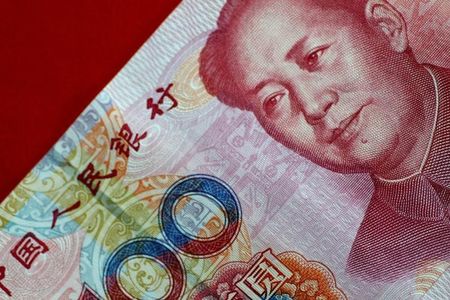
Investing.com– Most Asian currencies edged lower on Tuesday, with the Chinese yuan dropping to a four-month low against a stronger dollar after U.S. President-elect Donald Trump said he will impose additional trade tariffs on China, Mexico, and Canada.
Trump threatened to impose a 25% tariff on all products from Mexico and Canada, and an additional 10% tariff on goods from China.
The dollar Index rallied in Asian trade, and was last up 0.2% after paring some gains. On Monday, the appointment Scott Bessent as Treasury Secretary had led to a sharp fall in U.S. yields and put the greenback on the backfoot.
The Chinese onshore yuan’s USD/CNY pair rose 0.3% to its highest level since late July, while the offshore yuan USD/CNH was last up 0.2%.
Other regional currencies were also under pressure as concerns about global economic growth and trade friction weighed on sentiment.
The Singaporean dollar’s USD/SGD pair rose 0.2%, while the Thai baht’s USD/THB was 0.3% higher.
The Australian dollar’s AUD/USD pair, which is sensitive to any trade ructions for China, fell 0.2%.
In contrast, the Japanese yen’s USD/JPY pair fell 0.4% as traders sought safe-haven assets amid renewed trade tensions.
Trump’s tariff vow creates pressure on Asian markets
Trump has previously vowed to revoke China’s most-favored-nation trading status and impose tariffs of over 60% on Chinese imports, a significant increase compared to the tariffs enacted during his first term.
For Asian markets, Trump’s tariff policies are creating a challenging environment. The uncertainty over future U.S. trade policies, compounded by a stronger dollar and rising inflationary pressures, has increased the volatility of currencies across the region.
Economies that are highly dependent on exports, such as South Korea, Taiwan, and Malaysia, could face lower growth as U.S. demand for Asian goods weakens.
The South Korean won’s USD/KRW pair, and the Taiwanese dollar’s USD/TWD both edged 0.1% higher. The Malaysian ringgit’s USD/MYR pair climbed 0.3%.
Regional economies with larger domestic consumption, like India and Indonesia, may be somewhat insulated from the direct impact of tariffs. However, rising costs for imported goods and potential disruptions to global supply chains could still weigh on inflation and consumer sentiment.
The Indian rupee’s USD/INR pair was largely unchanged at 84.28, remaining close to recent record highs.
BOK rate decision, Fed cues in focus
South Korea’s central bank is set to decide on interest rates on Wednesday, while India is set to release its third-quarter GDP report on Friday, and China its purchasing managers index data on Saturday.
In the U.S., the Federal Reserve’s preferred measure of inflation, the personal consumption expenditures (PCE) price index, is due on Wednesday, which could provide cues on Fed’s rate outlook. The minutes of the Fed’s November meeting are due later on Thursday.
This post is originally published on INVESTING.


